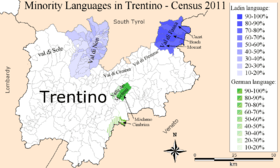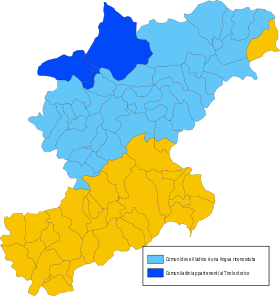Ladin Dolomitan
| Languages of South Tyrol. Majorities per municipality in 2011: | |
|---|---|
 |
Ladin Dolomitan or standard Ladin is the standard written constructed language (Dachsprache) based on the similarities of the five main dialect-groups of Ladin. It is the desired outcome of the project called SPELL (Servisc per la Planificazion y Elaborazion dl Lingaz Ladin – "service for the planning and preparation of the Ladin language")[1] under the initiative of The Union Generala di Ladins dles Dolomites (project owner) and the Ladin cultural institutes Micurà de Rü and Majon di Fascegn and Istitut Pedagogich Ladin to create a unified standard written language.
| Languages of Trentino. Percentage per municipality in 2011: | |
|---|---|
 |
| Languages of the Province of Belluno. Recognized Ladin area | |
|---|---|
 |
History
The contract to work on the project was given in 1988 by representatives from the Dolomite Ladins to the Zurich Professor Heinrich Schmid, who had previously designed the Dachsprache Rumantsch Grischun written language. Schmid accepted this challenge and in 1998 he published for standard Ladin its Guidelines for the Development of a Common Written Language of the Dolomite Ladins (Wegleitung für den Aufbau einer gemeinsamen Schriftsprache der Dolomitenladiner), in which the outlines for the new written language were presented. All written forms of Ladin Dolomitan words are carried over from spoken forms already existing in the spoken dialects based on a principle of the lowest common denominator in language formation.
Goals and current status
The goal of Ladin Dolomitan is not to replace or displace the existing Ladin languages of the different valleys but rather to serve as a Dachsprache and standard language for communication between speakers of the different dialects. This may also reduce the administrative burden of authorities and organization, which are not only linked to a single valley. For example, it allows for the administration of the South Tyrol to use a single Ladin language form for the communities in Val Gardena and Val Badia. However, the reception of Ladin Dolomitan is varied, there is great resistance in Val Gardena, while in Val Badia, in the Fassa Valley and Fodom the majority of the population is quite open-minded. Today, some institutions, such as the Union Generela di Ladins dles Dolomites (the umbrella organization of the Sella Ladin), the Comunanza Ladina de Bulsan, and the Free University of Bozen-Bolzano use Ladin Dolomitan as the default language taken in their publications.